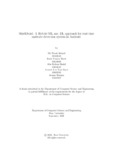| dc.contributor.advisor | Hossain, Muhammad Iqbal | |
| dc.contributor.advisor | Ashraf, Faisal Bin | |
| dc.contributor.author | Ahmed, Md Faisal | |
| dc.contributor.author | Biash, Zarin Tasnim | |
| dc.contributor.author | Shakil, Abu Raihan | |
| dc.contributor.author | Ryen, Ahmed Ann Noor | |
| dc.contributor.author | Hossain, Arman | |
| dc.date.accessioned | 2021-10-26T06:28:41Z | |
| dc.date.available | 2021-10-26T06:28:41Z | |
| dc.date.copyright | 2021 | |
| dc.date.issued | 2021-09 | |
| dc.identifier.other | ID 21341042 | |
| dc.identifier.other | ID 18141008 | |
| dc.identifier.other | ID 18101632 | |
| dc.identifier.other | ID 18101583 | |
| dc.identifier.other | ID 18101707 | |
| dc.identifier.uri | http://hdl.handle.net/10361/15550 | |
| dc.description | This thesis is submitted in partial fulfillment of the requirements for the degree of Bachelor of Science in Computer Science and Engineering, 2021. | en_US |
| dc.description | Cataloged from PDF version of thesis. | |
| dc.description | Includes bibliographical references (pages 40-41). | |
| dc.description.abstract | Due to the rapid development of the advanced world of technology, there is a high
increase in devices such as smartphones and tablets, which increase the number of
applications used. Though an application has to pass the malware detection test
before appearing in the play store, many applications successfully get trusted and
accepted even though they contain malicious software variants that are challenging
to detect. The application requires physical execution to see these malicious
contents, which get undetected during the rst screening test. Due to the physical
implementation of the application, it may be too late to undo the malware's
damage. In this work, the usage of real-time Android malware detection analyzing
Android applications to detect and swiftly distinguish complex malware has been
discussed. This work focuses on the use of dynamic algorithms implemented by hybrid
detection techniques of Android malware. After ltrating the collected dataset,
the process of separation between harmful and benign apps is discussed. Then summarization
and evaluation of the various techniques and classi cation algorithms
employed have been discussed, identifying the best-suited method that gives the
most accurate result in a minimum amount of time. The best way to reach the
target is a hybrid Random Forest, and Multilayer perceptron network, where the
overall accuracy achieved was 97.5% with an execution time of 22.945 seconds. An
Android application, namely,\Shield: Malware Scanner", was developed using Java
in determining if malware is present in an application. If there is any malware, it
detects the type of malware and advises the user on securing their data and privacy
and recovering from it. | en_US |
| dc.description.statementofresponsibility | Md Faisal Ahmed | |
| dc.description.statementofresponsibility | Zarin Tasnim Biash | |
| dc.description.statementofresponsibility | Abu Raihan Shakil | |
| dc.description.statementofresponsibility | Ahmed Ann Noor Ryen | |
| dc.description.statementofresponsibility | Arman Hossain | |
| dc.format.extent | 41 pages | |
| dc.language.iso | en | en_US |
| dc.publisher | Brac University | en_US |
| dc.rights | Brac University theses are protected by copyright. They may be viewed from this source for any purpose, but reproduction or distribution in any format is prohibited without written permission. | |
| dc.subject | Malware analysis | en_US |
| dc.subject | Cyber-security | en_US |
| dc.subject | Malware detection | en_US |
| dc.subject | Real-time analysis | en_US |
| dc.subject | Android application Neural network | en_US |
| dc.subject.lcsh | Computer security | |
| dc.subject.lcsh | Malware (Computer software) | |
| dc.subject.lcsh | Machine learning | |
| dc.subject.lcsh | Application software--Development | |
| dc.subject.lcsh | Mobile computing | |
| dc.title | ShielDroid: a hybrid ML and DL approach for real-time malware detection system in Android | en_US |
| dc.type | Thesis | en_US |
| dc.contributor.department | Department of Computer Science and Engineering, Brac University | |
| dc.description.degree | B. Computer Science | |

